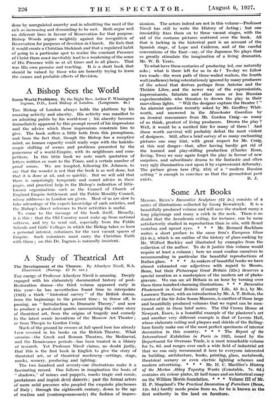A Study of Theatrical Art
The Development of the Theatre. By Allardyce Nicoll, M.A. Illustrated. (Harrap. £2 2s. net.)
T.UE energy of Professor Allardyce Nicoll is amazing. Deeply engaged with his elaborately documented history of post- Restoration drama—the third volume appeared early in this year—he has nevertheless found time to interpolate (1925) a thick historical survey " of the British drama, from the beginnings to the present time ; to throw off, in passing, an " Introduction to Dramatic Theory," and now to produce a good-sized quarto summarizing the entire story of theatrical art, from the origins of tragedy and comedy to the latest scenic inventions of the Moscow Art Theatre ; or from Thespis to Gordon Craig.
Much of the ground he crosses at full speed here has already 1 .een covered in his books on the British Theatre. What remains—the Greek and Roman Theatres, the Mediaeval, and the Renaissance periods—has been treated in a library of research. Yet Professor Nicoll claims, no doubt justly, that this is the first book in English to give the story of theatrical art, or of theatrical machinery—settings, stage, masks, scenery, producing and lighting.
The two hundred and seventy-one illustrations make it a fascinating record. One follows in imagination the hosts of " shadows," of mimes and puppets, masks tragic and comic,
pantaloons and impish devil dancers ; past the formal actors
of more solid presence who peopled the exquisite playhouses of Italy ; through the eighteenth century, down to the age of realism and (contemporaneously) the fashion of impres-
sionism. The actors indeed are not in this volume—Professor Nicoll has still to write the History of Acting ; but one irresistibly fixes them on to these vacant stages, with the aid of the costume pictures scattered over the book. All that is lacking in the historical part is an account of the Spanish stage, of Lope and Calderon, and of the careful conventions of the East—say, of the Japanese No plays that so greatly stimulate the imagination of a living dramatist, Mr. W. B. Yeats.
To what have these centuries of producing led, one naturally asks ; what is there left for us to do ? To-day we follow two roads—the worn path of three-walled realism, the fourth wall (audience) being ostentatiously ignored by many producers of the school that derives perhaps from Antoine and the Theatre Libre, and the newer way of the expressionists, impressionists, futurists and other more or less Russian experimentalists who threaten to drown the play in their
marvellous lights. Will the designer capture the theatre ? " An alarmist question recently asked by Mr. Geoffrey Whit- worth, and answered in the Manchester Guardian by an ironical reassurance from Mr. Gordon Craig—as many of us think, greatest of living producers. Drown the play ? Well, it would be a merited fate for many of them ! And those worth survival will probably defeat the most violent of designers. Still, after a brief survey of so many enchanting pictures one may hint, with great respect for Mr. Craig, at this real danger—that, after having hardly got rid of the learned and play-stifling production (Charles Kean, Irving, Tree) we may again forget the play in favour of new surprises, and subordinate drama to the fantastic and often very ugly illumination cast upon it by expressionist deformity. The picture given here (Fig. 254) of a " modern Russian setting " is enough to convince us that the geometrical peril






































 Previous page
Previous page